Fitness Exercise: Trainer's Role in Modifying, Adapting, and Machines
VerifiedAdded on 2021/11/03
|11
|2625
|90
Homework Assignment
AI Summary
This assignment delves into the realm of fitness training, exploring how trainers can modify exercises to alter intensity levels and ensure participant safety. It covers a range of exercises, including lunges, push-ups, burpees, planks, high knees, kickbacks, sit-ups, vertical jumps, and front kicks, detailing the joints, bones, and muscles involved. The assignment also examines how trainers can adapt these exercises by manipulating forces and levers to increase or decrease difficulty and ensure safe and effective movement. Furthermore, it provides an overview of cardiovascular machines, such as treadmills, ellipticals, bicycles, cross-fit cycles, and surf machines, explaining their benefits and how to instruct clients on their proper use. Finally, it explores strength training machines, including seated leg curls, bicep curls, pectoral fly, shoulder press, iso-lateral bench press, triceps extensions, seated dips, and abdominal/oblique crunches, detailing their start positions, form, and techniques. This comprehensive analysis highlights the trainer's role in designing safe and effective fitness programs.
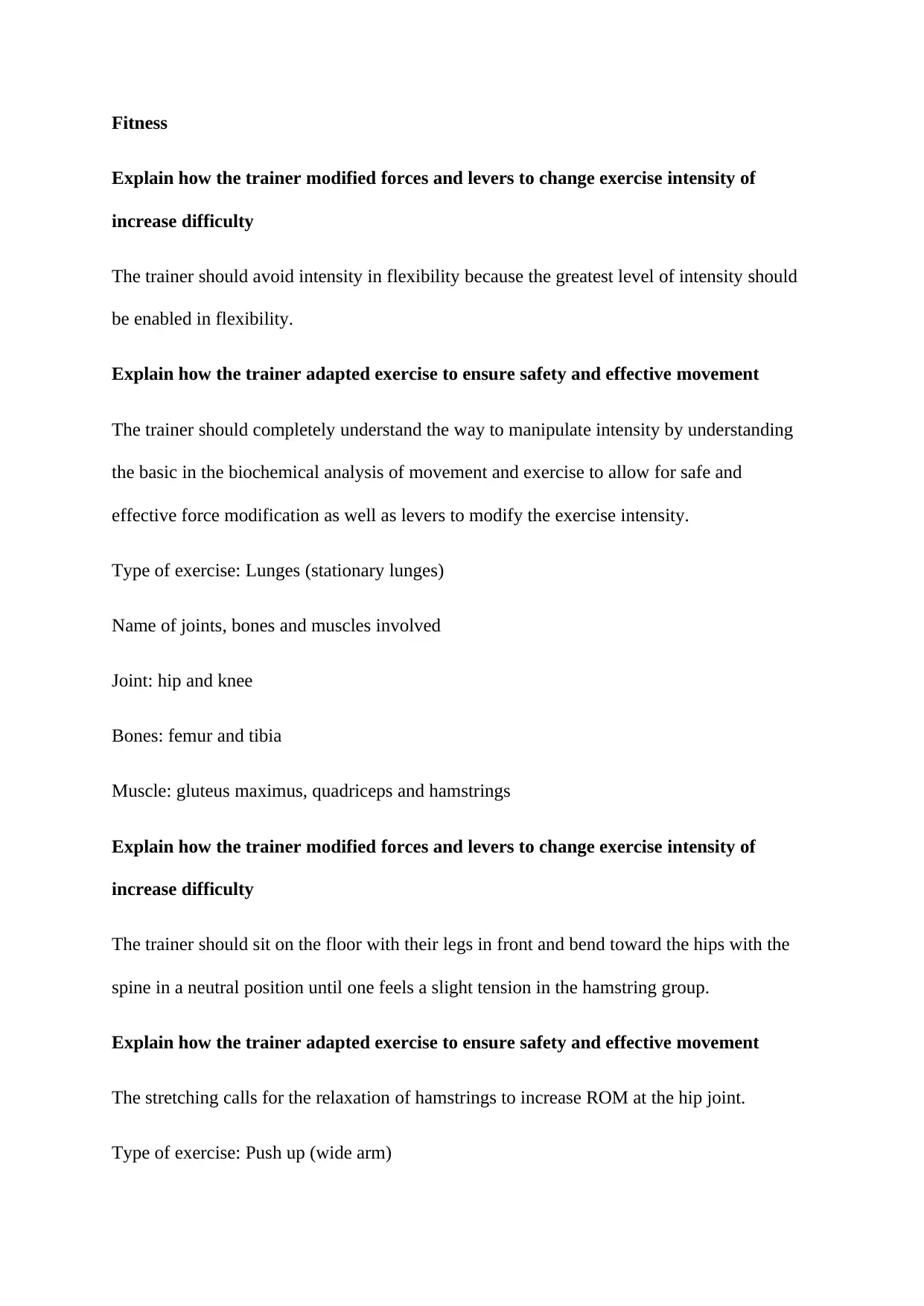
Fitness
Explain how the trainer modified forces and levers to change exercise intensity of
increase difficulty
The trainer should avoid intensity in flexibility because the greatest level of intensity should
be enabled in flexibility.
Explain how the trainer adapted exercise to ensure safety and effective movement
The trainer should completely understand the way to manipulate intensity by understanding
the basic in the biochemical analysis of movement and exercise to allow for safe and
effective force modification as well as levers to modify the exercise intensity.
Type of exercise: Lunges (stationary lunges)
Name of joints, bones and muscles involved
Joint: hip and knee
Bones: femur and tibia
Muscle: gluteus maximus, quadriceps and hamstrings
Explain how the trainer modified forces and levers to change exercise intensity of
increase difficulty
The trainer should sit on the floor with their legs in front and bend toward the hips with the
spine in a neutral position until one feels a slight tension in the hamstring group.
Explain how the trainer adapted exercise to ensure safety and effective movement
The stretching calls for the relaxation of hamstrings to increase ROM at the hip joint.
Type of exercise: Push up (wide arm)
Explain how the trainer modified forces and levers to change exercise intensity of
increase difficulty
The trainer should avoid intensity in flexibility because the greatest level of intensity should
be enabled in flexibility.
Explain how the trainer adapted exercise to ensure safety and effective movement
The trainer should completely understand the way to manipulate intensity by understanding
the basic in the biochemical analysis of movement and exercise to allow for safe and
effective force modification as well as levers to modify the exercise intensity.
Type of exercise: Lunges (stationary lunges)
Name of joints, bones and muscles involved
Joint: hip and knee
Bones: femur and tibia
Muscle: gluteus maximus, quadriceps and hamstrings
Explain how the trainer modified forces and levers to change exercise intensity of
increase difficulty
The trainer should sit on the floor with their legs in front and bend toward the hips with the
spine in a neutral position until one feels a slight tension in the hamstring group.
Explain how the trainer adapted exercise to ensure safety and effective movement
The stretching calls for the relaxation of hamstrings to increase ROM at the hip joint.
Type of exercise: Push up (wide arm)
Paraphrase This Document
Need a fresh take? Get an instant paraphrase of this document with our AI Paraphraser
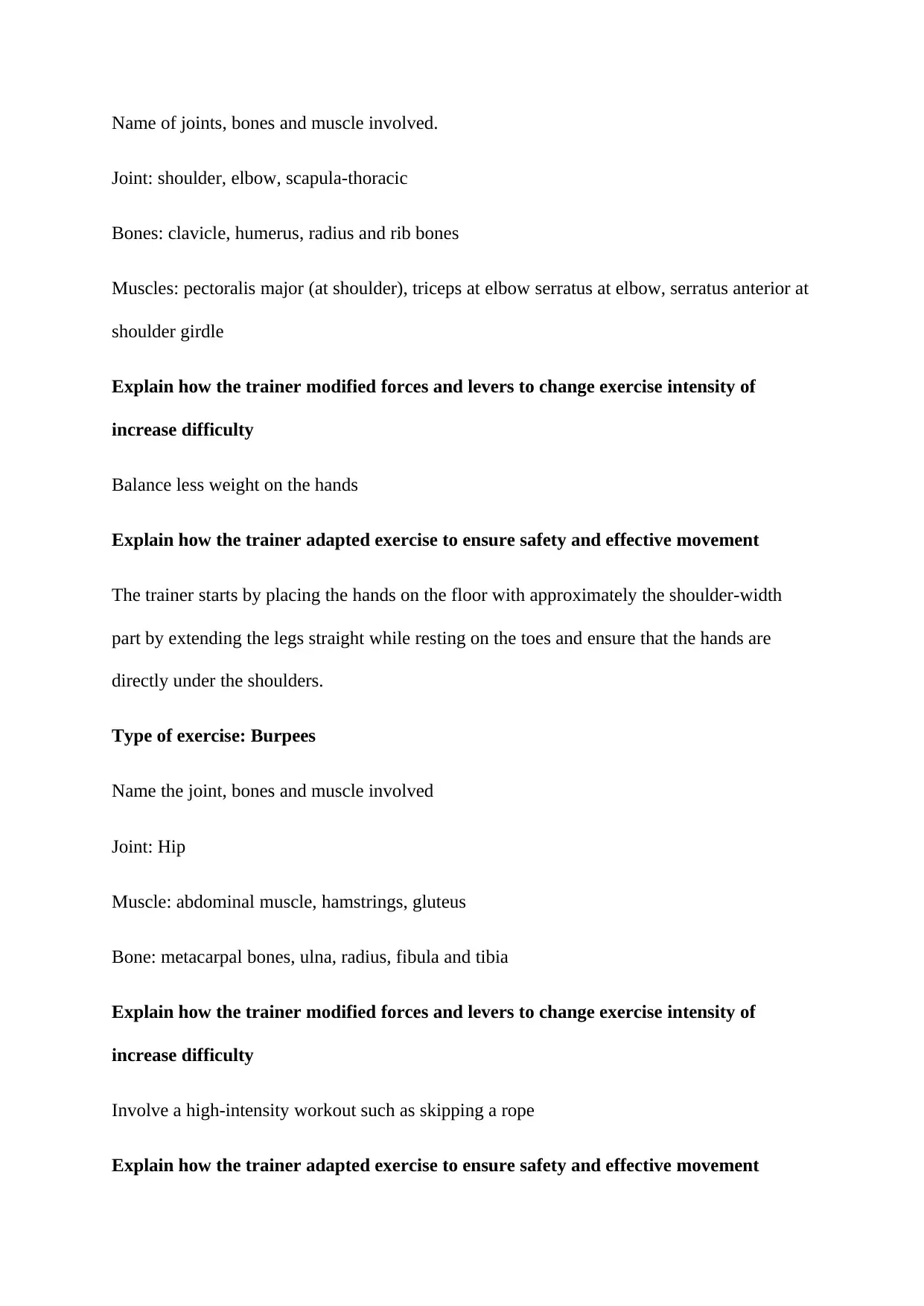
Name of joints, bones and muscle involved.
Joint: shoulder, elbow, scapula-thoracic
Bones: clavicle, humerus, radius and rib bones
Muscles: pectoralis major (at shoulder), triceps at elbow serratus at elbow, serratus anterior at
shoulder girdle
Explain how the trainer modified forces and levers to change exercise intensity of
increase difficulty
Balance less weight on the hands
Explain how the trainer adapted exercise to ensure safety and effective movement
The trainer starts by placing the hands on the floor with approximately the shoulder-width
part by extending the legs straight while resting on the toes and ensure that the hands are
directly under the shoulders.
Type of exercise: Burpees
Name the joint, bones and muscle involved
Joint: Hip
Muscle: abdominal muscle, hamstrings, gluteus
Bone: metacarpal bones, ulna, radius, fibula and tibia
Explain how the trainer modified forces and levers to change exercise intensity of
increase difficulty
Involve a high-intensity workout such as skipping a rope
Explain how the trainer adapted exercise to ensure safety and effective movement
Joint: shoulder, elbow, scapula-thoracic
Bones: clavicle, humerus, radius and rib bones
Muscles: pectoralis major (at shoulder), triceps at elbow serratus at elbow, serratus anterior at
shoulder girdle
Explain how the trainer modified forces and levers to change exercise intensity of
increase difficulty
Balance less weight on the hands
Explain how the trainer adapted exercise to ensure safety and effective movement
The trainer starts by placing the hands on the floor with approximately the shoulder-width
part by extending the legs straight while resting on the toes and ensure that the hands are
directly under the shoulders.
Type of exercise: Burpees
Name the joint, bones and muscle involved
Joint: Hip
Muscle: abdominal muscle, hamstrings, gluteus
Bone: metacarpal bones, ulna, radius, fibula and tibia
Explain how the trainer modified forces and levers to change exercise intensity of
increase difficulty
Involve a high-intensity workout such as skipping a rope
Explain how the trainer adapted exercise to ensure safety and effective movement
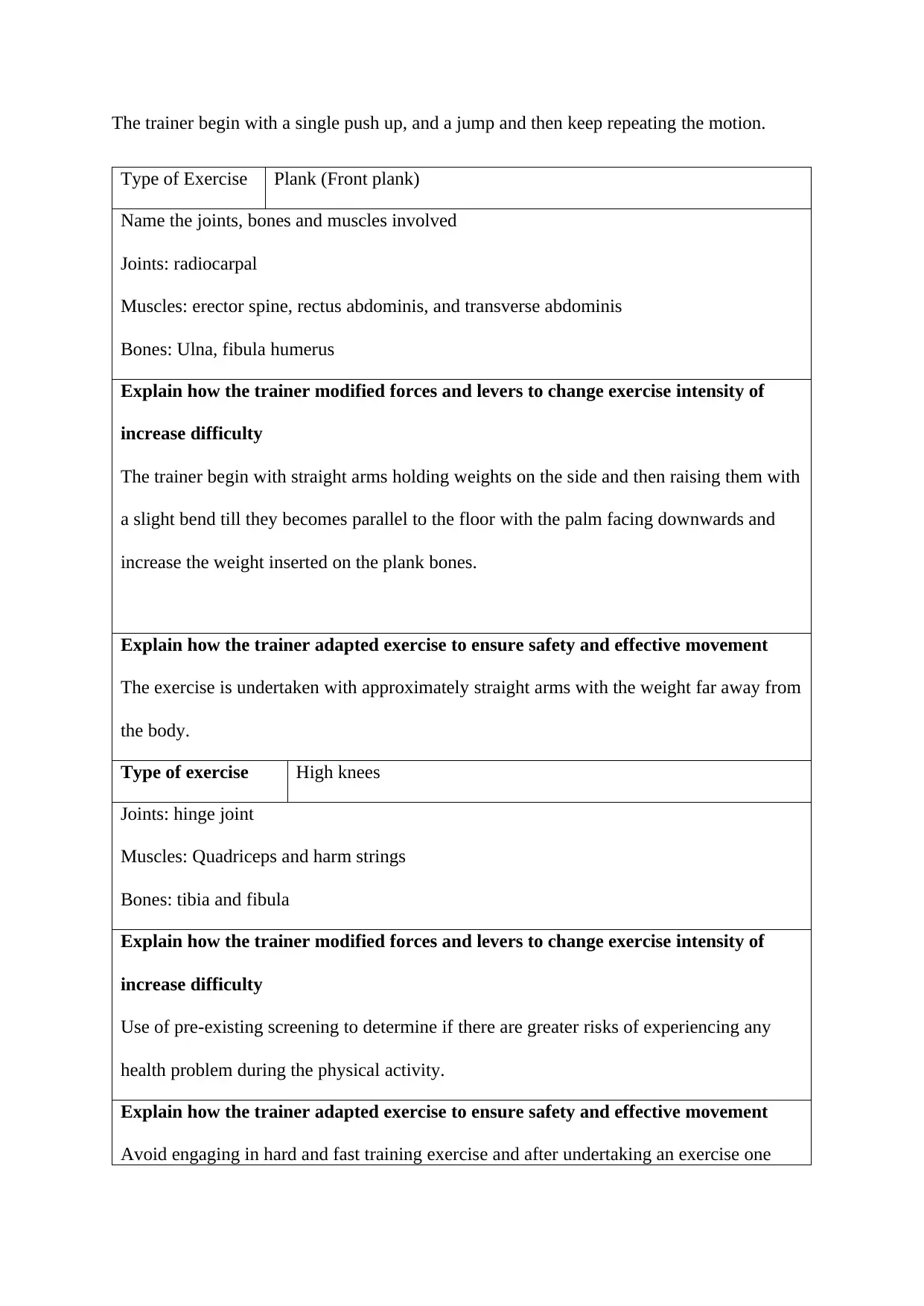
The trainer begin with a single push up, and a jump and then keep repeating the motion.
Type of Exercise Plank (Front plank)
Name the joints, bones and muscles involved
Joints: radiocarpal
Muscles: erector spine, rectus abdominis, and transverse abdominis
Bones: Ulna, fibula humerus
Explain how the trainer modified forces and levers to change exercise intensity of
increase difficulty
The trainer begin with straight arms holding weights on the side and then raising them with
a slight bend till they becomes parallel to the floor with the palm facing downwards and
increase the weight inserted on the plank bones.
Explain how the trainer adapted exercise to ensure safety and effective movement
The exercise is undertaken with approximately straight arms with the weight far away from
the body.
Type of exercise High knees
Joints: hinge joint
Muscles: Quadriceps and harm strings
Bones: tibia and fibula
Explain how the trainer modified forces and levers to change exercise intensity of
increase difficulty
Use of pre-existing screening to determine if there are greater risks of experiencing any
health problem during the physical activity.
Explain how the trainer adapted exercise to ensure safety and effective movement
Avoid engaging in hard and fast training exercise and after undertaking an exercise one
Type of Exercise Plank (Front plank)
Name the joints, bones and muscles involved
Joints: radiocarpal
Muscles: erector spine, rectus abdominis, and transverse abdominis
Bones: Ulna, fibula humerus
Explain how the trainer modified forces and levers to change exercise intensity of
increase difficulty
The trainer begin with straight arms holding weights on the side and then raising them with
a slight bend till they becomes parallel to the floor with the palm facing downwards and
increase the weight inserted on the plank bones.
Explain how the trainer adapted exercise to ensure safety and effective movement
The exercise is undertaken with approximately straight arms with the weight far away from
the body.
Type of exercise High knees
Joints: hinge joint
Muscles: Quadriceps and harm strings
Bones: tibia and fibula
Explain how the trainer modified forces and levers to change exercise intensity of
increase difficulty
Use of pre-existing screening to determine if there are greater risks of experiencing any
health problem during the physical activity.
Explain how the trainer adapted exercise to ensure safety and effective movement
Avoid engaging in hard and fast training exercise and after undertaking an exercise one
⊘ This is a preview!⊘
Do you want full access?
Subscribe today to unlock all pages.

Trusted by 1+ million students worldwide
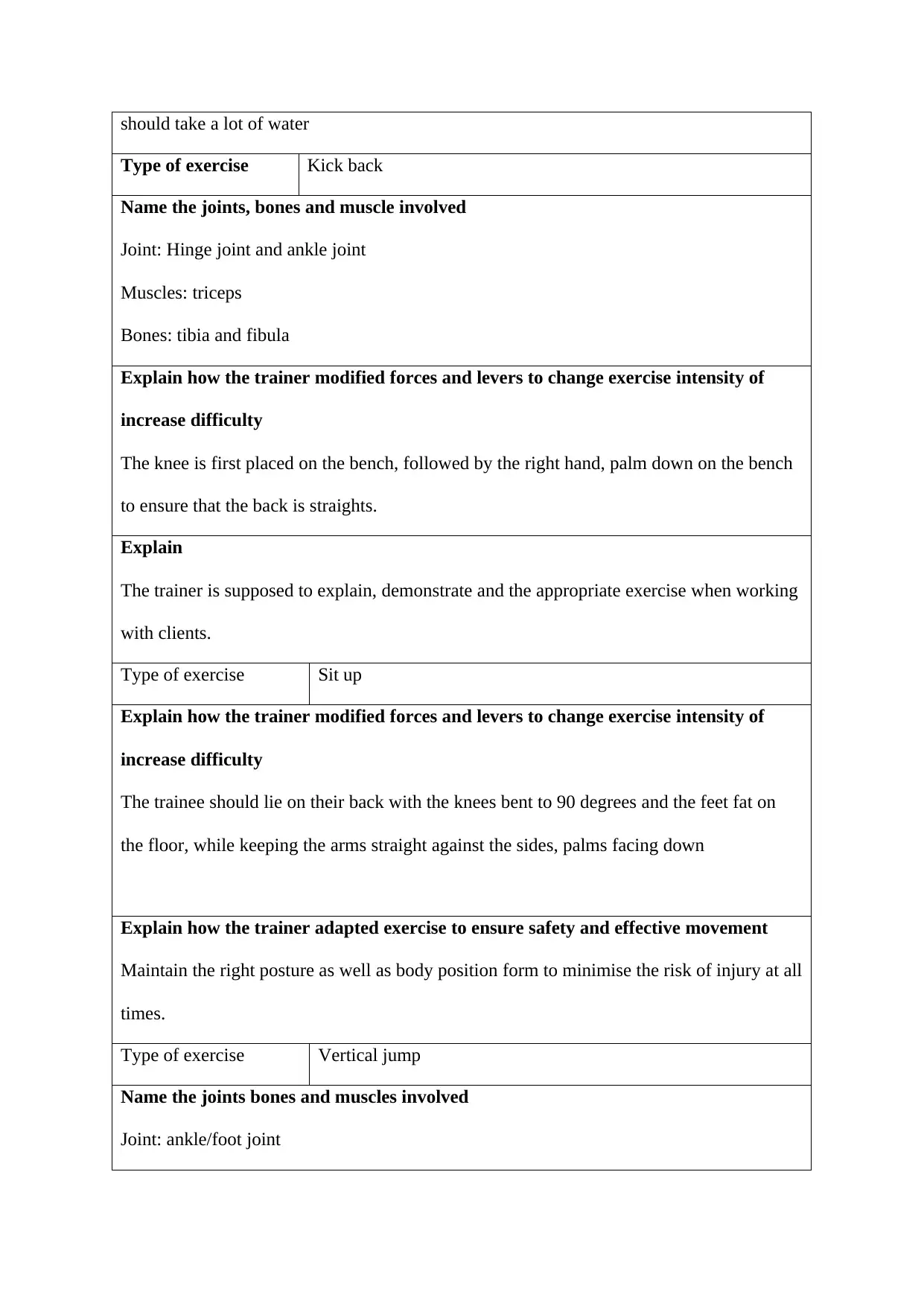
should take a lot of water
Type of exercise Kick back
Name the joints, bones and muscle involved
Joint: Hinge joint and ankle joint
Muscles: triceps
Bones: tibia and fibula
Explain how the trainer modified forces and levers to change exercise intensity of
increase difficulty
The knee is first placed on the bench, followed by the right hand, palm down on the bench
to ensure that the back is straights.
Explain
The trainer is supposed to explain, demonstrate and the appropriate exercise when working
with clients.
Type of exercise Sit up
Explain how the trainer modified forces and levers to change exercise intensity of
increase difficulty
The trainee should lie on their back with the knees bent to 90 degrees and the feet fat on
the floor, while keeping the arms straight against the sides, palms facing down
Explain how the trainer adapted exercise to ensure safety and effective movement
Maintain the right posture as well as body position form to minimise the risk of injury at all
times.
Type of exercise Vertical jump
Name the joints bones and muscles involved
Joint: ankle/foot joint
Type of exercise Kick back
Name the joints, bones and muscle involved
Joint: Hinge joint and ankle joint
Muscles: triceps
Bones: tibia and fibula
Explain how the trainer modified forces and levers to change exercise intensity of
increase difficulty
The knee is first placed on the bench, followed by the right hand, palm down on the bench
to ensure that the back is straights.
Explain
The trainer is supposed to explain, demonstrate and the appropriate exercise when working
with clients.
Type of exercise Sit up
Explain how the trainer modified forces and levers to change exercise intensity of
increase difficulty
The trainee should lie on their back with the knees bent to 90 degrees and the feet fat on
the floor, while keeping the arms straight against the sides, palms facing down
Explain how the trainer adapted exercise to ensure safety and effective movement
Maintain the right posture as well as body position form to minimise the risk of injury at all
times.
Type of exercise Vertical jump
Name the joints bones and muscles involved
Joint: ankle/foot joint
Paraphrase This Document
Need a fresh take? Get an instant paraphrase of this document with our AI Paraphraser
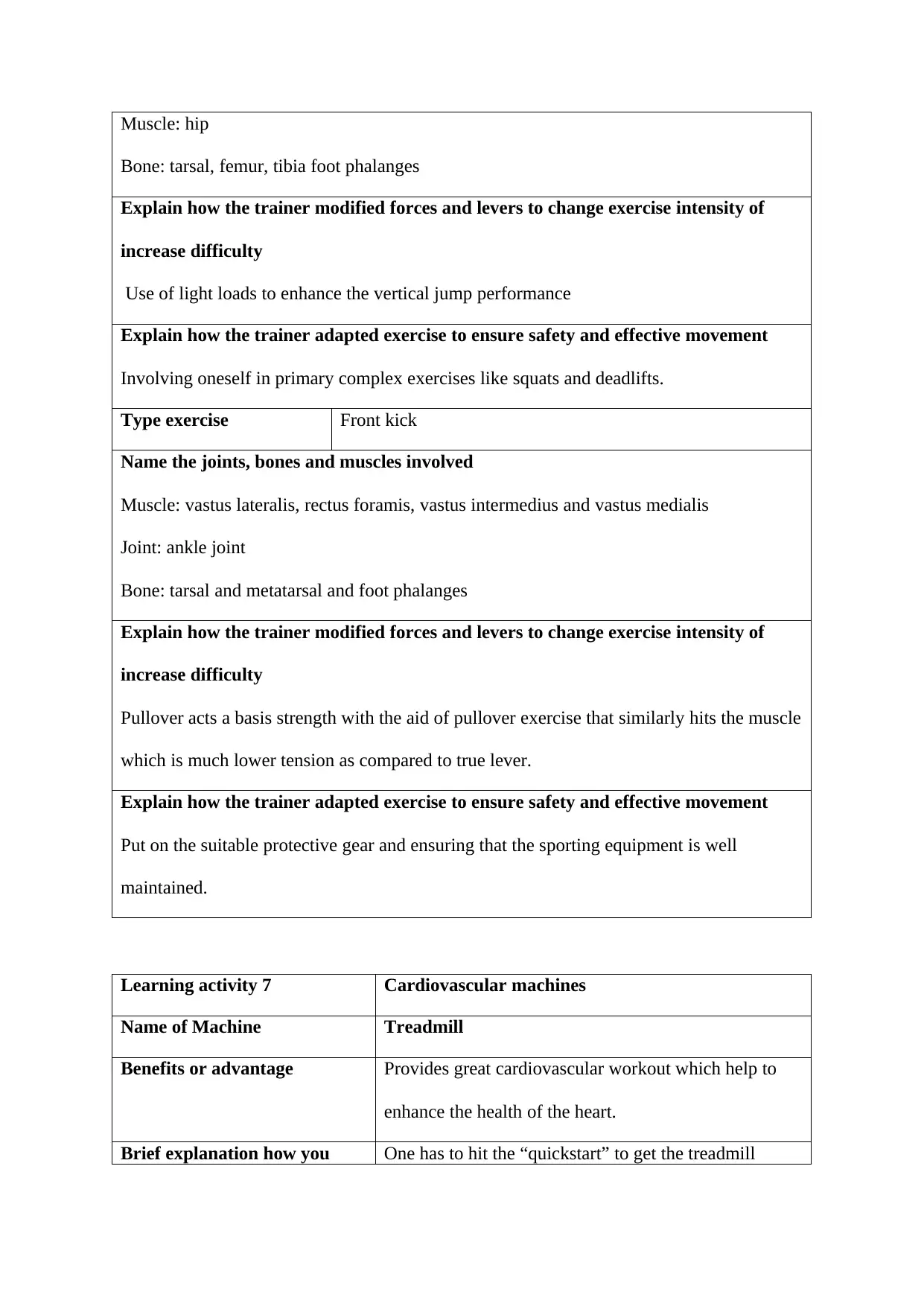
Muscle: hip
Bone: tarsal, femur, tibia foot phalanges
Explain how the trainer modified forces and levers to change exercise intensity of
increase difficulty
Use of light loads to enhance the vertical jump performance
Explain how the trainer adapted exercise to ensure safety and effective movement
Involving oneself in primary complex exercises like squats and deadlifts.
Type exercise Front kick
Name the joints, bones and muscles involved
Muscle: vastus lateralis, rectus foramis, vastus intermedius and vastus medialis
Joint: ankle joint
Bone: tarsal and metatarsal and foot phalanges
Explain how the trainer modified forces and levers to change exercise intensity of
increase difficulty
Pullover acts a basis strength with the aid of pullover exercise that similarly hits the muscle
which is much lower tension as compared to true lever.
Explain how the trainer adapted exercise to ensure safety and effective movement
Put on the suitable protective gear and ensuring that the sporting equipment is well
maintained.
Learning activity 7 Cardiovascular machines
Name of Machine Treadmill
Benefits or advantage Provides great cardiovascular workout which help to
enhance the health of the heart.
Brief explanation how you One has to hit the “quickstart” to get the treadmill
Bone: tarsal, femur, tibia foot phalanges
Explain how the trainer modified forces and levers to change exercise intensity of
increase difficulty
Use of light loads to enhance the vertical jump performance
Explain how the trainer adapted exercise to ensure safety and effective movement
Involving oneself in primary complex exercises like squats and deadlifts.
Type exercise Front kick
Name the joints, bones and muscles involved
Muscle: vastus lateralis, rectus foramis, vastus intermedius and vastus medialis
Joint: ankle joint
Bone: tarsal and metatarsal and foot phalanges
Explain how the trainer modified forces and levers to change exercise intensity of
increase difficulty
Pullover acts a basis strength with the aid of pullover exercise that similarly hits the muscle
which is much lower tension as compared to true lever.
Explain how the trainer adapted exercise to ensure safety and effective movement
Put on the suitable protective gear and ensuring that the sporting equipment is well
maintained.
Learning activity 7 Cardiovascular machines
Name of Machine Treadmill
Benefits or advantage Provides great cardiovascular workout which help to
enhance the health of the heart.
Brief explanation how you One has to hit the “quickstart” to get the treadmill
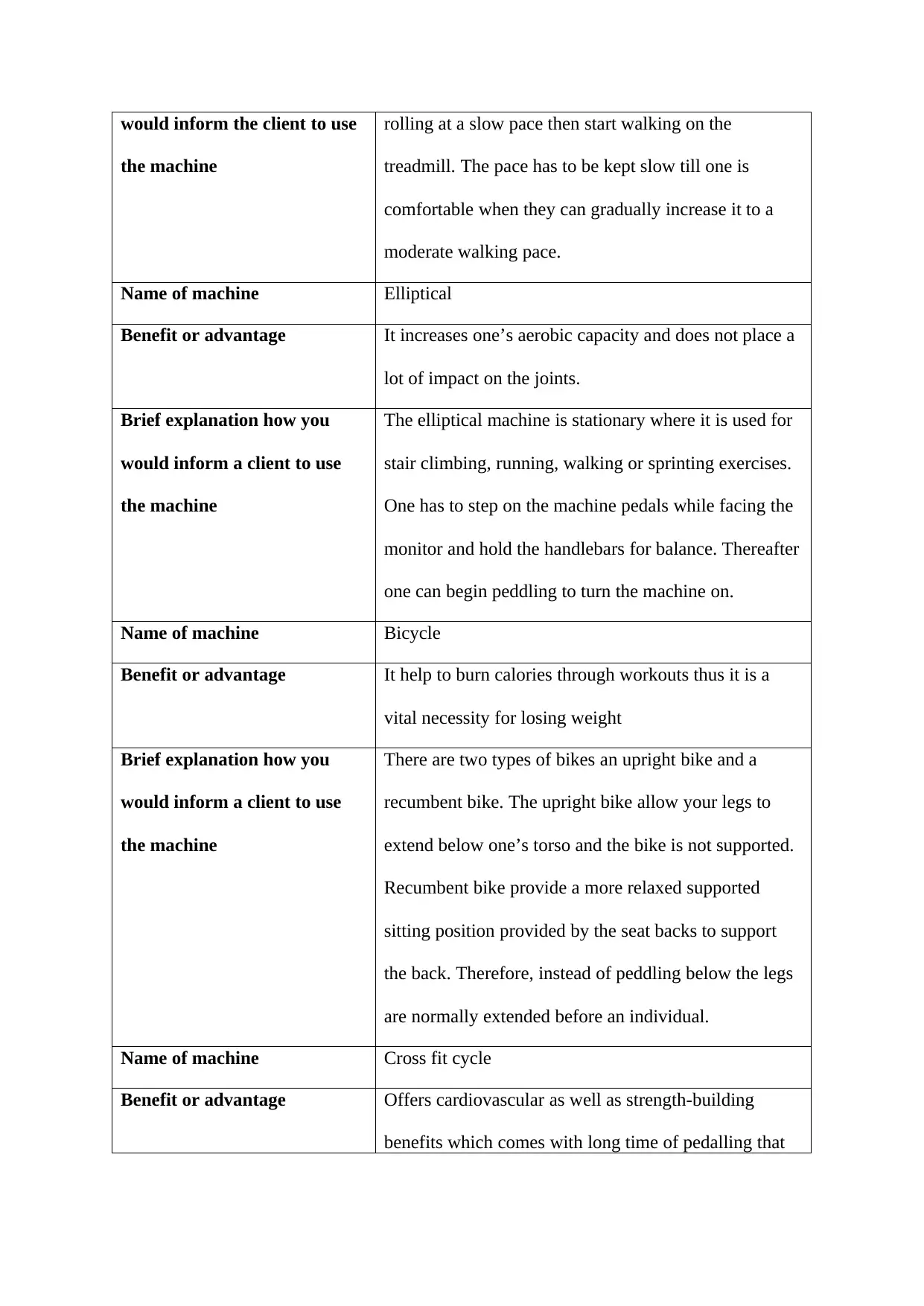
would inform the client to use
the machine
rolling at a slow pace then start walking on the
treadmill. The pace has to be kept slow till one is
comfortable when they can gradually increase it to a
moderate walking pace.
Name of machine Elliptical
Benefit or advantage It increases one’s aerobic capacity and does not place a
lot of impact on the joints.
Brief explanation how you
would inform a client to use
the machine
The elliptical machine is stationary where it is used for
stair climbing, running, walking or sprinting exercises.
One has to step on the machine pedals while facing the
monitor and hold the handlebars for balance. Thereafter
one can begin peddling to turn the machine on.
Name of machine Bicycle
Benefit or advantage It help to burn calories through workouts thus it is a
vital necessity for losing weight
Brief explanation how you
would inform a client to use
the machine
There are two types of bikes an upright bike and a
recumbent bike. The upright bike allow your legs to
extend below one’s torso and the bike is not supported.
Recumbent bike provide a more relaxed supported
sitting position provided by the seat backs to support
the back. Therefore, instead of peddling below the legs
are normally extended before an individual.
Name of machine Cross fit cycle
Benefit or advantage Offers cardiovascular as well as strength-building
benefits which comes with long time of pedalling that
the machine
rolling at a slow pace then start walking on the
treadmill. The pace has to be kept slow till one is
comfortable when they can gradually increase it to a
moderate walking pace.
Name of machine Elliptical
Benefit or advantage It increases one’s aerobic capacity and does not place a
lot of impact on the joints.
Brief explanation how you
would inform a client to use
the machine
The elliptical machine is stationary where it is used for
stair climbing, running, walking or sprinting exercises.
One has to step on the machine pedals while facing the
monitor and hold the handlebars for balance. Thereafter
one can begin peddling to turn the machine on.
Name of machine Bicycle
Benefit or advantage It help to burn calories through workouts thus it is a
vital necessity for losing weight
Brief explanation how you
would inform a client to use
the machine
There are two types of bikes an upright bike and a
recumbent bike. The upright bike allow your legs to
extend below one’s torso and the bike is not supported.
Recumbent bike provide a more relaxed supported
sitting position provided by the seat backs to support
the back. Therefore, instead of peddling below the legs
are normally extended before an individual.
Name of machine Cross fit cycle
Benefit or advantage Offers cardiovascular as well as strength-building
benefits which comes with long time of pedalling that
⊘ This is a preview!⊘
Do you want full access?
Subscribe today to unlock all pages.

Trusted by 1+ million students worldwide
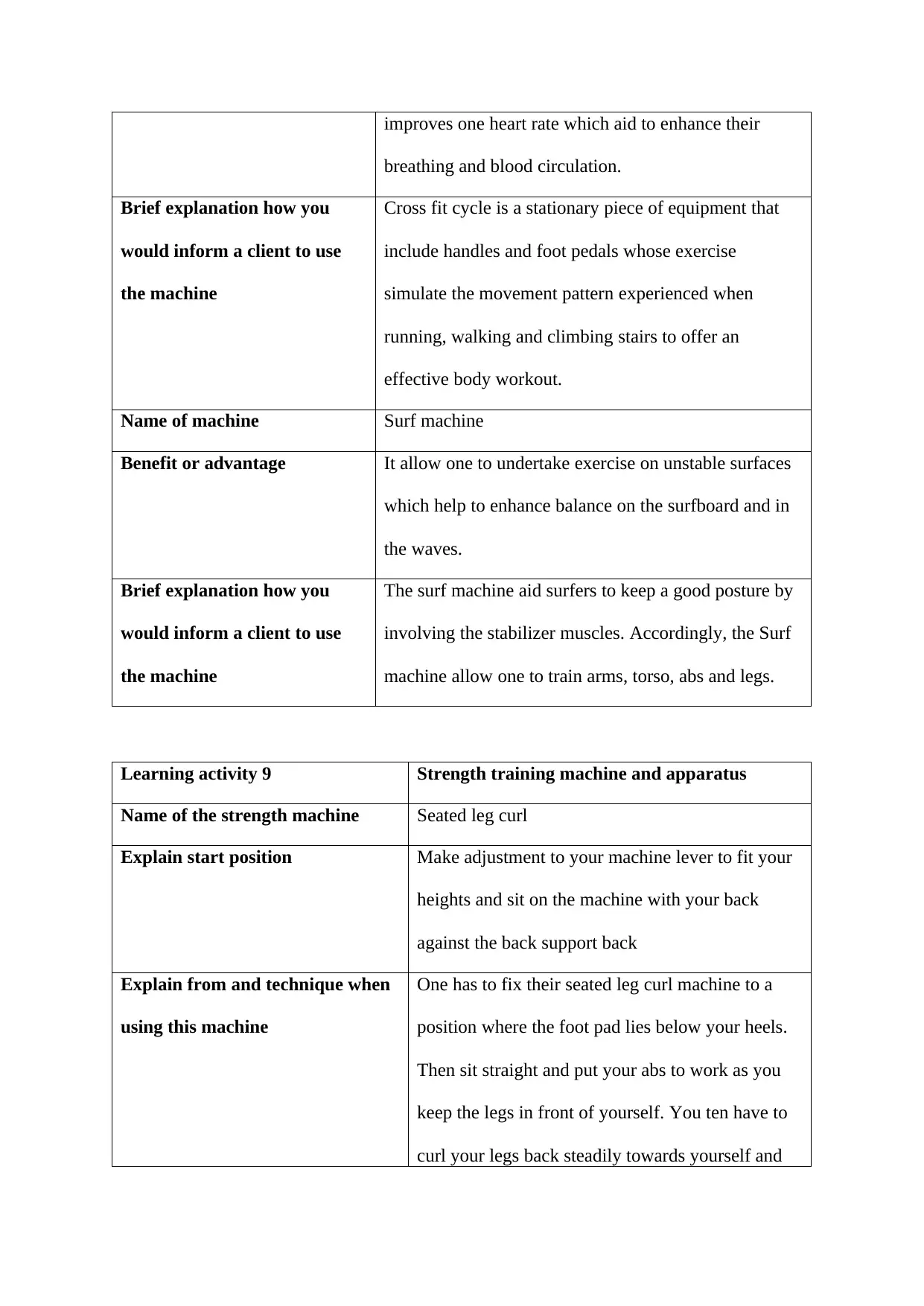
improves one heart rate which aid to enhance their
breathing and blood circulation.
Brief explanation how you
would inform a client to use
the machine
Cross fit cycle is a stationary piece of equipment that
include handles and foot pedals whose exercise
simulate the movement pattern experienced when
running, walking and climbing stairs to offer an
effective body workout.
Name of machine Surf machine
Benefit or advantage It allow one to undertake exercise on unstable surfaces
which help to enhance balance on the surfboard and in
the waves.
Brief explanation how you
would inform a client to use
the machine
The surf machine aid surfers to keep a good posture by
involving the stabilizer muscles. Accordingly, the Surf
machine allow one to train arms, torso, abs and legs.
Learning activity 9 Strength training machine and apparatus
Name of the strength machine Seated leg curl
Explain start position Make adjustment to your machine lever to fit your
heights and sit on the machine with your back
against the back support back
Explain from and technique when
using this machine
One has to fix their seated leg curl machine to a
position where the foot pad lies below your heels.
Then sit straight and put your abs to work as you
keep the legs in front of yourself. You ten have to
curl your legs back steadily towards yourself and
breathing and blood circulation.
Brief explanation how you
would inform a client to use
the machine
Cross fit cycle is a stationary piece of equipment that
include handles and foot pedals whose exercise
simulate the movement pattern experienced when
running, walking and climbing stairs to offer an
effective body workout.
Name of machine Surf machine
Benefit or advantage It allow one to undertake exercise on unstable surfaces
which help to enhance balance on the surfboard and in
the waves.
Brief explanation how you
would inform a client to use
the machine
The surf machine aid surfers to keep a good posture by
involving the stabilizer muscles. Accordingly, the Surf
machine allow one to train arms, torso, abs and legs.
Learning activity 9 Strength training machine and apparatus
Name of the strength machine Seated leg curl
Explain start position Make adjustment to your machine lever to fit your
heights and sit on the machine with your back
against the back support back
Explain from and technique when
using this machine
One has to fix their seated leg curl machine to a
position where the foot pad lies below your heels.
Then sit straight and put your abs to work as you
keep the legs in front of yourself. You ten have to
curl your legs back steadily towards yourself and
Paraphrase This Document
Need a fresh take? Get an instant paraphrase of this document with our AI Paraphraser
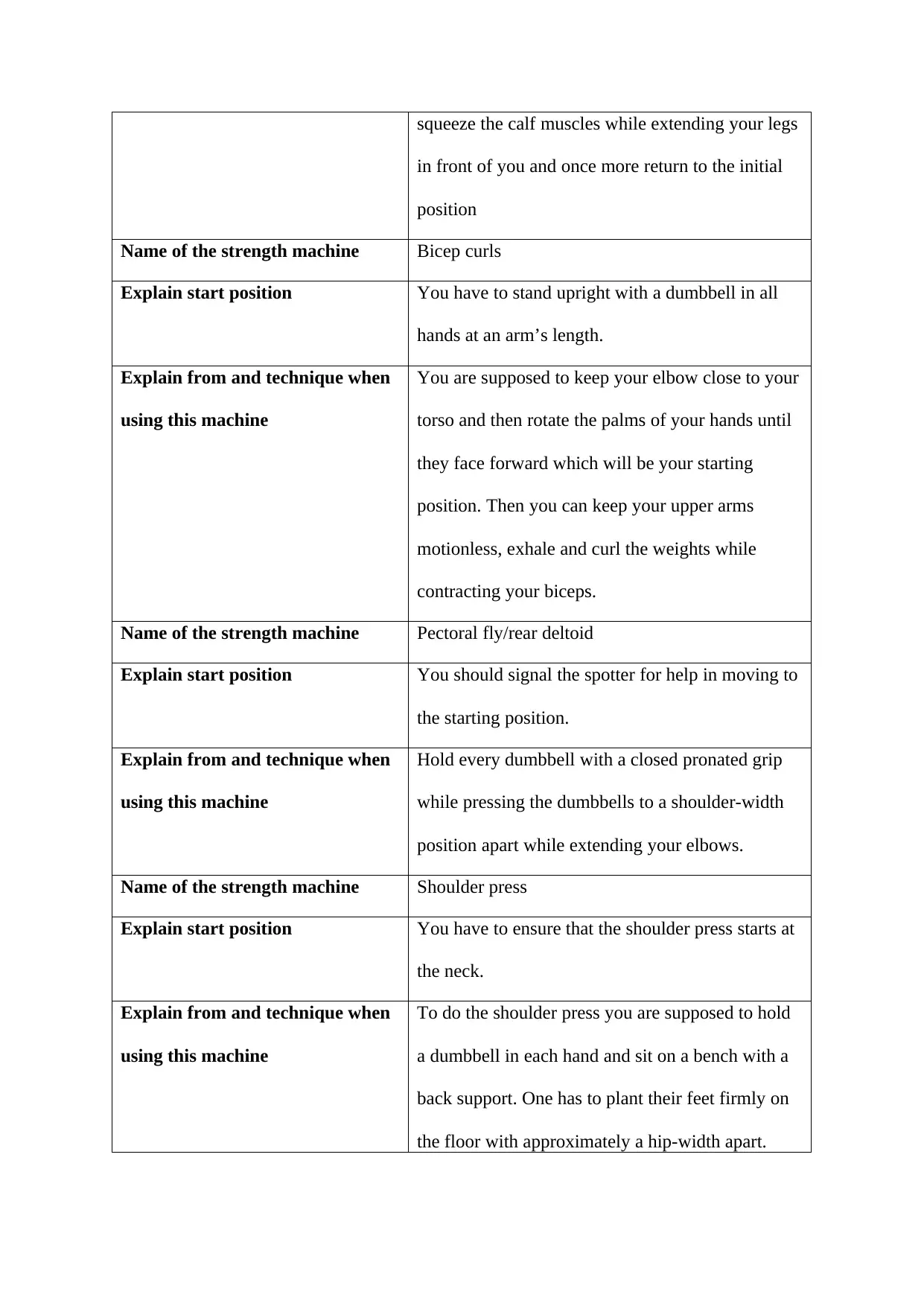
squeeze the calf muscles while extending your legs
in front of you and once more return to the initial
position
Name of the strength machine Bicep curls
Explain start position You have to stand upright with a dumbbell in all
hands at an arm’s length.
Explain from and technique when
using this machine
You are supposed to keep your elbow close to your
torso and then rotate the palms of your hands until
they face forward which will be your starting
position. Then you can keep your upper arms
motionless, exhale and curl the weights while
contracting your biceps.
Name of the strength machine Pectoral fly/rear deltoid
Explain start position You should signal the spotter for help in moving to
the starting position.
Explain from and technique when
using this machine
Hold every dumbbell with a closed pronated grip
while pressing the dumbbells to a shoulder-width
position apart while extending your elbows.
Name of the strength machine Shoulder press
Explain start position You have to ensure that the shoulder press starts at
the neck.
Explain from and technique when
using this machine
To do the shoulder press you are supposed to hold
a dumbbell in each hand and sit on a bench with a
back support. One has to plant their feet firmly on
the floor with approximately a hip-width apart.
in front of you and once more return to the initial
position
Name of the strength machine Bicep curls
Explain start position You have to stand upright with a dumbbell in all
hands at an arm’s length.
Explain from and technique when
using this machine
You are supposed to keep your elbow close to your
torso and then rotate the palms of your hands until
they face forward which will be your starting
position. Then you can keep your upper arms
motionless, exhale and curl the weights while
contracting your biceps.
Name of the strength machine Pectoral fly/rear deltoid
Explain start position You should signal the spotter for help in moving to
the starting position.
Explain from and technique when
using this machine
Hold every dumbbell with a closed pronated grip
while pressing the dumbbells to a shoulder-width
position apart while extending your elbows.
Name of the strength machine Shoulder press
Explain start position You have to ensure that the shoulder press starts at
the neck.
Explain from and technique when
using this machine
To do the shoulder press you are supposed to hold
a dumbbell in each hand and sit on a bench with a
back support. One has to plant their feet firmly on
the floor with approximately a hip-width apart.
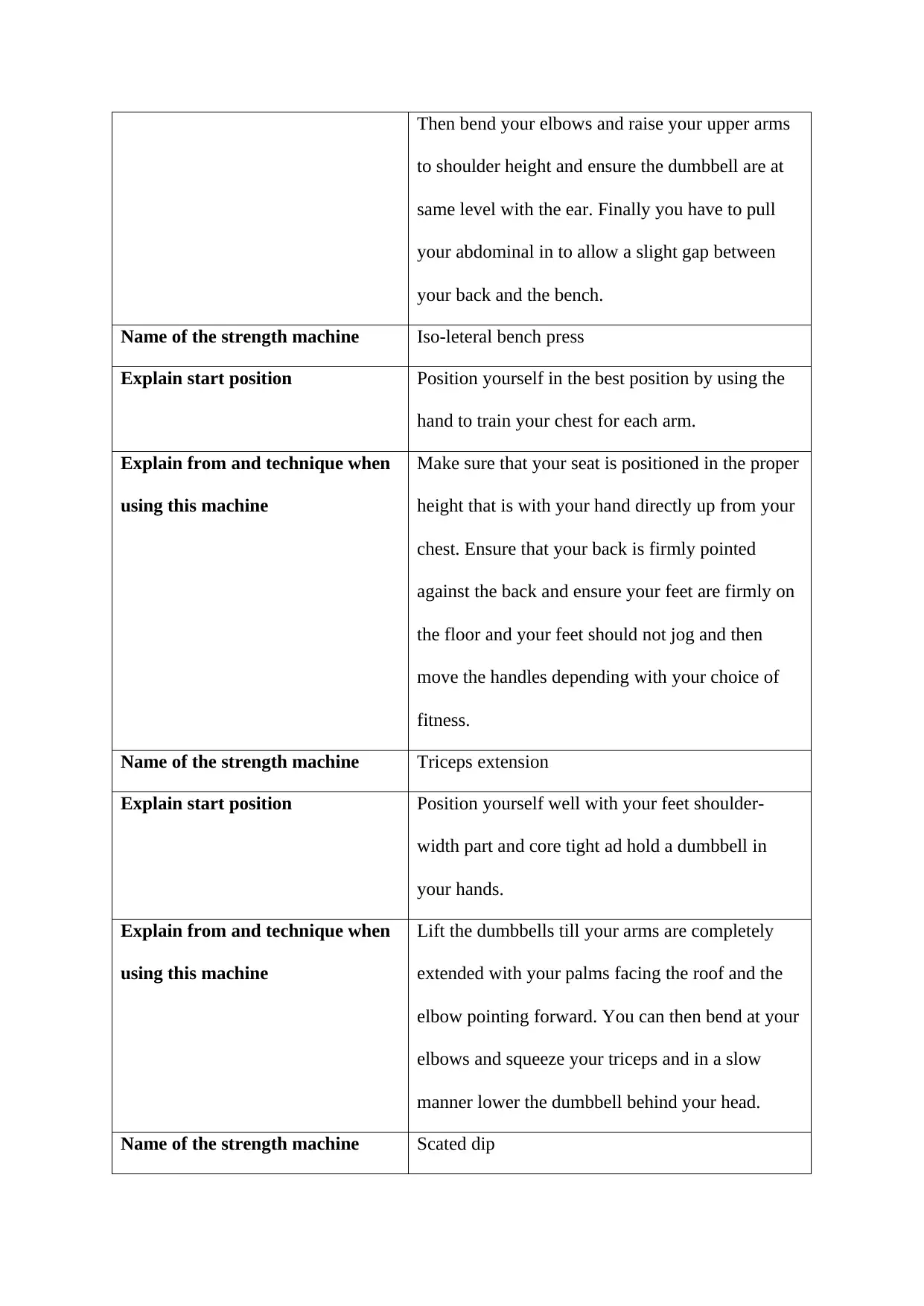
Then bend your elbows and raise your upper arms
to shoulder height and ensure the dumbbell are at
same level with the ear. Finally you have to pull
your abdominal in to allow a slight gap between
your back and the bench.
Name of the strength machine Iso-leteral bench press
Explain start position Position yourself in the best position by using the
hand to train your chest for each arm.
Explain from and technique when
using this machine
Make sure that your seat is positioned in the proper
height that is with your hand directly up from your
chest. Ensure that your back is firmly pointed
against the back and ensure your feet are firmly on
the floor and your feet should not jog and then
move the handles depending with your choice of
fitness.
Name of the strength machine Triceps extension
Explain start position Position yourself well with your feet shoulder-
width part and core tight ad hold a dumbbell in
your hands.
Explain from and technique when
using this machine
Lift the dumbbells till your arms are completely
extended with your palms facing the roof and the
elbow pointing forward. You can then bend at your
elbows and squeeze your triceps and in a slow
manner lower the dumbbell behind your head.
Name of the strength machine Scated dip
to shoulder height and ensure the dumbbell are at
same level with the ear. Finally you have to pull
your abdominal in to allow a slight gap between
your back and the bench.
Name of the strength machine Iso-leteral bench press
Explain start position Position yourself in the best position by using the
hand to train your chest for each arm.
Explain from and technique when
using this machine
Make sure that your seat is positioned in the proper
height that is with your hand directly up from your
chest. Ensure that your back is firmly pointed
against the back and ensure your feet are firmly on
the floor and your feet should not jog and then
move the handles depending with your choice of
fitness.
Name of the strength machine Triceps extension
Explain start position Position yourself well with your feet shoulder-
width part and core tight ad hold a dumbbell in
your hands.
Explain from and technique when
using this machine
Lift the dumbbells till your arms are completely
extended with your palms facing the roof and the
elbow pointing forward. You can then bend at your
elbows and squeeze your triceps and in a slow
manner lower the dumbbell behind your head.
Name of the strength machine Scated dip
⊘ This is a preview!⊘
Do you want full access?
Subscribe today to unlock all pages.

Trusted by 1+ million students worldwide
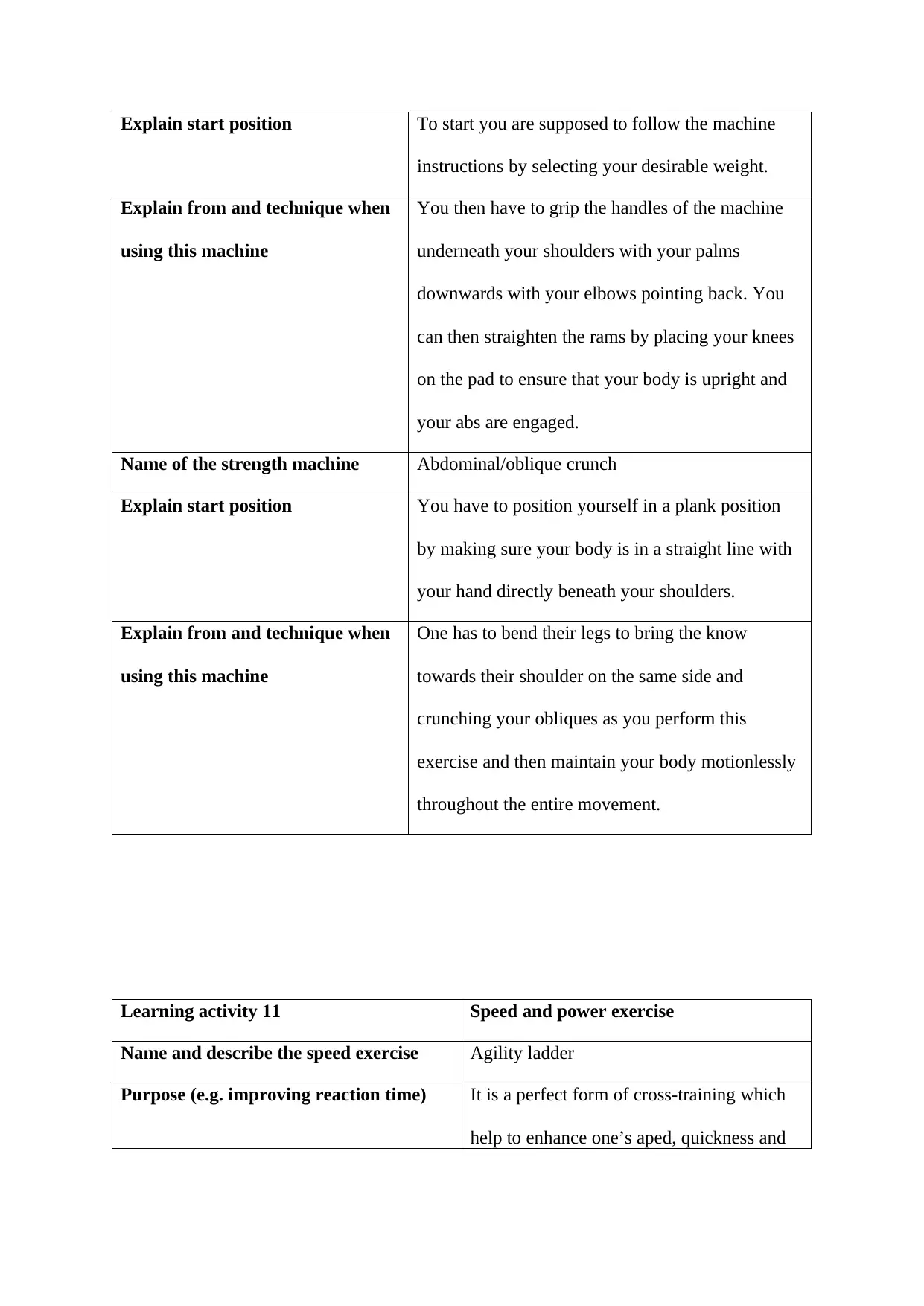
Explain start position To start you are supposed to follow the machine
instructions by selecting your desirable weight.
Explain from and technique when
using this machine
You then have to grip the handles of the machine
underneath your shoulders with your palms
downwards with your elbows pointing back. You
can then straighten the rams by placing your knees
on the pad to ensure that your body is upright and
your abs are engaged.
Name of the strength machine Abdominal/oblique crunch
Explain start position You have to position yourself in a plank position
by making sure your body is in a straight line with
your hand directly beneath your shoulders.
Explain from and technique when
using this machine
One has to bend their legs to bring the know
towards their shoulder on the same side and
crunching your obliques as you perform this
exercise and then maintain your body motionlessly
throughout the entire movement.
Learning activity 11 Speed and power exercise
Name and describe the speed exercise Agility ladder
Purpose (e.g. improving reaction time) It is a perfect form of cross-training which
help to enhance one’s aped, quickness and
instructions by selecting your desirable weight.
Explain from and technique when
using this machine
You then have to grip the handles of the machine
underneath your shoulders with your palms
downwards with your elbows pointing back. You
can then straighten the rams by placing your knees
on the pad to ensure that your body is upright and
your abs are engaged.
Name of the strength machine Abdominal/oblique crunch
Explain start position You have to position yourself in a plank position
by making sure your body is in a straight line with
your hand directly beneath your shoulders.
Explain from and technique when
using this machine
One has to bend their legs to bring the know
towards their shoulder on the same side and
crunching your obliques as you perform this
exercise and then maintain your body motionlessly
throughout the entire movement.
Learning activity 11 Speed and power exercise
Name and describe the speed exercise Agility ladder
Purpose (e.g. improving reaction time) It is a perfect form of cross-training which
help to enhance one’s aped, quickness and
Paraphrase This Document
Need a fresh take? Get an instant paraphrase of this document with our AI Paraphraser

agility.
Name of equipment or accessory used Ladder
Technique for this exercise Speed that is the capability to move as fast
as possible in one direction
Quickness that is the capacity to switch
positions in quick manner.
Common errors you observed Failure to use the hip hinge in agility drills
Name and describe the speed exercise High knees (lateral) using cones
Purpose (e.g. improving reaction time) Develop strength as well as endurance of
the hip flexors, the quads, and stretches the
hip extensors
Name of equipment or accessory used Agility ladder, three cones and water bottle
Technique for this exercise Cones drills: you set apart seven cones in a
specific pattern using letters M, N, I, T, and
Y and then select an order in which you will
create these letters with your pattern of
moving across the cones.
Balloon drills: one uses two dissimilar
coloured balloons by picking an order in
which you will contact each.
Common errors you observed Missing the pattern to be followed
Name and describe the speed exercise Agility ladder squats (in and out)
Purpose (e.g. improving reaction time) Help to develop strength as well as
endurance in hip flexors, hamstrings and
enhance joint flexibility.
Name of equipment or accessory used Speed ladder
Name of equipment or accessory used Ladder
Technique for this exercise Speed that is the capability to move as fast
as possible in one direction
Quickness that is the capacity to switch
positions in quick manner.
Common errors you observed Failure to use the hip hinge in agility drills
Name and describe the speed exercise High knees (lateral) using cones
Purpose (e.g. improving reaction time) Develop strength as well as endurance of
the hip flexors, the quads, and stretches the
hip extensors
Name of equipment or accessory used Agility ladder, three cones and water bottle
Technique for this exercise Cones drills: you set apart seven cones in a
specific pattern using letters M, N, I, T, and
Y and then select an order in which you will
create these letters with your pattern of
moving across the cones.
Balloon drills: one uses two dissimilar
coloured balloons by picking an order in
which you will contact each.
Common errors you observed Missing the pattern to be followed
Name and describe the speed exercise Agility ladder squats (in and out)
Purpose (e.g. improving reaction time) Help to develop strength as well as
endurance in hip flexors, hamstrings and
enhance joint flexibility.
Name of equipment or accessory used Speed ladder
1 out of 11
Your All-in-One AI-Powered Toolkit for Academic Success.
+13062052269
info@desklib.com
Available 24*7 on WhatsApp / Email
![[object Object]](/_next/static/media/star-bottom.7253800d.svg)
Unlock your academic potential
Copyright © 2020–2025 A2Z Services. All Rights Reserved. Developed and managed by ZUCOL.
